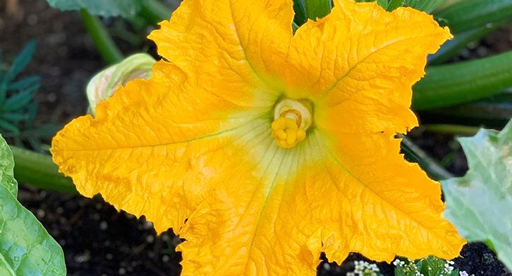
Courgettes or zucchinis are a summer vege garden staple for many Kiwi gardeners. With bright yellow flowers, they have a wide range of uses; grated into salads, stir-fries, quiches and preserves, or sliced and grilled on the BBQ.
Check out answers to common problems and tips to courgette success.
PLANTING & CARE
- Courgettes need heat and sun to flourish. They are frost-tender, so in cold areas don’t plant them outdoors until November.
- Courgettes bear male and female flowers, however only the female flowers produce fruit. Once the male flowers open and release their pollen, they fall off. The female flowers (which have a small courgette) need to be pollinated by the male flowers. You can do this by hand by rubbing the pollen from the male flower onto the female flower. Often at the start of the season courgette plants produce more male blooms to ensure there's plenty of pollen for when the female blooms open.
- Feed courgettes as they grow to promote healthy growth and flowering. Apply Tui Vegetable Food every four weeks for courgettes planted in the garden, or use a liquid option like Tui Seaweed & Fish fertiliser.
- Feed courgettes planted in pots and containers with Tui NovaTec Premium fertiliser.
- While your courgettes are growing regular applications of Tui Organic Seaweed Plant Tonic will provide a welcome boost and help the plant cope with the summer heat, and make plants more resilient to pest and disease.
- Harvest courgettes when they are 15-20cm long. Once they get beyond this they become a marrow. Make sure you cut the courgettes off the plant rather than snapping them off as this can rip the main trunk of the plant.
Common issues
- If your courgettes are producing finger length fruit and then yellowing and dropping off, it is most likely blossom end rot. This is caused by a lack of water, irregular watering or a lack of calcium and magnesium in the soil. Make sure your courgettes get regular watering which is adjusted according to the weather. Apply a side dressing of Tui Dolomite Lime to correct any calcium and magnesium deficiency.
- Powdery mildew can be a common problem with courgettes, especially in humid conditions. Planting too close together can assist the spread of powdery mildew as airflow is reduced. Try thinning and pruning plants to create airflow and water plants at soil level to avoid the fungus being spread. Natural fungicide spray options are available from garden centres.
Harvesting
- Harvest courgettes when they are 15-20cm long. Once they get beyond this they become a marrow. Make sure you cut the courgettes off the plant rather than snapping them off as this can rip the main trunk of the plant.
Try the below recipes with your harvests:
Planting tips:
If you are starting with an existing garden bed dig in organic matter like Tui Sheep Pellets and compost to your soil. Then you can add a layer of Tui Vegetable Mix.
If planting in pots and containers, fill with Tui Vegetable Mix.
Plant courgette seedlings about 50-80cm apart as the leaves can get quite big and mildew can be a problem as they grow, so plenty of room is important.
Post a comment
Top Courgette Tips Comments
Thank you for this newsletter. It is so useful.
Sandra duncan
Love your newsletters and all the information in it as I grow veges and have a lot of shrubs and flowers plus bulbs in the garden.
Trish Moir
I will give my plants dolomite lime today. Thankyou for the tip
Ann Hows
Thanks so much, dolomite lime has done the trick, no more yellow ended zucchinis.
Joan Roesch
Many thanks for the newsletters; I've gained useful gardening knowledge from them.
Ray Moore